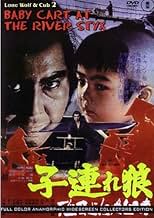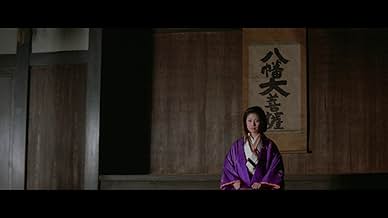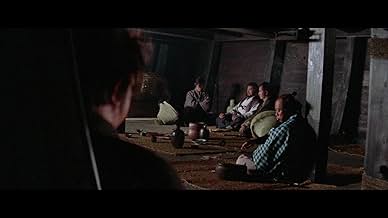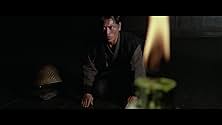Aggiungi una trama nella tua linguaTrailed by a clan of female ninja, Ogami is paid to assassinate a clan traitor accompanied by three killers known as the Gods of Death.Trailed by a clan of female ninja, Ogami is paid to assassinate a clan traitor accompanied by three killers known as the Gods of Death.Trailed by a clan of female ninja, Ogami is paid to assassinate a clan traitor accompanied by three killers known as the Gods of Death.
- Mitsugu
- (as Kanji Ebata)
Recensioni in evidenza
This one has the Lone Wolf and his Cub still enjoying the "misadventures" of samurai-for-hire, and of course their quest for vengeance against the Yagyu clan that initially betrayed them. Some intriguing enemies in this one includes a band of female ninjas and the "Gods Of Death". There is also the requisite side story of Itto's "hit of the day"...
This one has some pretty fast-and-furious fight scenes and is probably the most action packed of the series. Again, like the other entries, good acting, great sets and costumes, beautiful camera-work, and the almost magical but extremely unorthodox "chemistry" between father and son are not to be missed. Highly Recommended 9/10
Forget Toshiro Mifune. Forget Takakura Ken. Forget Sonny Chiba. Forget Bruce Lee, Jackie Chan, Jet Li, Donnie Yen, and any of those wire-reliant ballet dancers from Crouching Tiger Hidden Dragon. And CERTAINLY forget any American martial artists that you could care to name. Tomisaburo Wakayama was, is, and forever shall be, THE MAN!
When the wealthy Awa clan approach Itto, offering him 500 gold pieces to kill a man who might be able to ruin them financially, he accepts; in order to complete his mission, he must face many dangers, including a team of vicious female warriors, and the highly skilled Hidari brothers, also known as the Gods of Death.
Baby Cart at the River Styx sees director Kenji Misumi delivering a breathtaking sequel to his excellent Sword of Vengeance. Like a Japanese Sergio Leone, he once again uses extreme close-ups, rapid zooms, sparing use of a haunting soundtrack, and superbly choreographed violence to continue his epic tale of a man and boy on a gore-spattered journey through 'hell'.
From the opening scene in which Itto quickly dispatches of two Yagyu clansmen, through to the stunning climax which sees Lone Wolf and Cub battling the Hidaris in a desert, this film is a stunning and often beautiful display of carnage. Battles take place in complete silence, with the vanquished always taking a second or two before they fall to the ground, blood gushing from their wounds. Daigoro also gets in on the act, activating spring-loaded blades in his cart to slice off the feet of the enemy. Misumi's handling of these scenes is superb, with some great use of innovative and ground-breaking visual techniques (one great fight scene has images superimposed onto each other to give the action a surreal and dreamlike quality).
But it's not all mindless violence. There are occasional moments of tenderness too, with the close bond between father and son displayed in a couple of notable scenes: Ogami gently bathes Daigoro, with one hand on his sword in readiness for trouble; and Daigoro nurses his injured father back to health, trading his jacket for food.
My only gripe with Baby Cart at the River Styx is that the film is often very dark, and it was extremely hard to see what was going on, particularly during the many night scenes. Whilst this may be due to my DVD being a bad transfer, it did affect my enjoyment of the film (I had to re-watch the gory dismemberment of one unfortunate shinobi at the hands of the female ninjas with my TV's brightness and contrast whacked right up), which is why I give it slightly less than Sword of Vengeance7.5/10 (although I have to round my rating up to 8 for IMDb, which technically puts it on a par with the first one).
Lo sapevi?
- QuizThe distinctive hats worn by the Gods of Death, are a traditional Japanese straw hat often associated with ronin. The style of hat is known as roningasa. 'Ronin' meaning masterless and wandering samurai, and 'gasa' meaning hat.
- BlooperWhen Ogami and Daigoro are walking through the forest shortly before being attacked by Kurokawa and his ninja henchmen (around the 31:30 mark), cars can be seen driving by in the background on the left side of the frame.
- Citazioni
Benma Hidari: [Ogami Itto has bested him and slashed him across the neck with a sword; blood is starting to flow from the wound, making a certain sound] My neck... my own neck... It sounds like it's wailing. My neck was sliced open diagonally. The cut wails like a cold winter wind. They call it "mogari-bue," - the whistle of a fallen tiger. I've always wished to kill someone, just once, and create such a fine cut and to sing this tune. Now I'm hearing it from my own neck. What a laugh.
[rolls over dead, with blood spurting out from his neck wound onto the sand]
- ConnessioniEdited into Shogun il giustiziere (1980)
I più visti
- How long is Lone Wolf and Cub: Baby Cart at the River Styx?Powered by Alexa
Dettagli
- Data di uscita
- Paese di origine
- Lingua
- Celebre anche come
- Lone Wolf and Cub: Baby Cart at the River Styx
- Aziende produttrici
- Vedi altri crediti dell’azienda su IMDbPro
Contribuisci a questa pagina





























